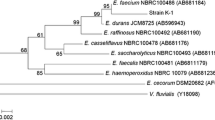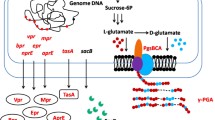Abstract
This study examined the efficacy of a Bacillus thuringiensis (Bt) strain in producing amylase (EC 3.2.1.1) as a by-product without affecting its unique ability for producing δ-endotoxin, thus to establish a cultivation strategy for the dual production and recovery of both δ-endotoxin and amylase from the fermented medium with an industrial perspective. LB medium was individually supplemented (5 to 100%, wt/vol) with flour from six naturally available starchy stored foods (banana, Bengal gram, jack seed, potato, taro or tapioca); after initial fermentation (12 h), the supernatant in the medium obtained by centrifugation (1000 g, 10 min) was used for harvesting amylase and the resultant pellet was further incubated aseptically for the production of endospores and δ-endotoxin by solid-state fermentation. Maximum crude amylase activity (867 U/gram dry substrate, 12 h) was observed in potato flour-supplemented medium (10% wt/vol, 12 h), while the activity in LB control was only 4.36 U/mL. SDS-PAGE profile of the crude (supernatant), as well as partially purified (40–60% (NH4)2SO4 fractionation) amylase showed that its apparent molecular mass was 51 kDa, which was further confirmed by native PAGE. The harvest of industrially significant extracellular amylase (probably α-amylase) produced as a byproduct during early growth phase would boost the economics of the Bt-based bio-industry engaged in δ-endotoxin production.
Similar content being viewed by others
References
Schnepf, E., Crickmore, N., Van, R.J., Lereclus, D., Baum, J., Feitelson, J., Zeigler, D.R., and Dean, D.H., Bacillus thuringiensis and its pesticidal crystal proteins, Microbiol. Mol. Biol. Rev., 1998, vol. 62, pp. 775–806.
Soberon, M., Gill, S.S., and Bravo, A., Signaling versus punching hole: How do Bacillus thuringiensis toxins kill insect midgut cells?, Cell. Mol. Life. Sci., 2009, vol. 66, pp. 1337–1349.
Li, E. and Yousten, A., Metalloproteases from Bacillus thuringiensis, Appl. Microbiol., 1975, vol. 30, pp. 354–361.
Kuppusamy, K. and Balaraman, K., Extra cellular hydrolytic enzyme secretion in Bacillus thuringiensis H14 & B. sphaericus and their significance in media design, Indian. J. Med. Res., 1990, vol. 91, pp. 149–150.
Vu, K.D., Tyagi, R.D., Valéro, J.R., and Surampalli, R.Y., Batch and fed-batch fermentation of Bacillus thuringiensis using starch industry wastewater as fermentation substrate, Bioprocess. Biosyst. Eng., 2010, vol. 33, pp. 691–700.
Thamthiankul, S., Suan-Ngay, S., Tantimavanich, S., and Panbangred, W., Chitinase from Bacillus thuringiensis subsp. pakistani, Appl. Microbiol. Biotechnol., 2001, vol. 56, pp. 395–401.
Bryant, J.E., Commercial production and formulation of Bacillus thuringiensis, Agric Ecosys. Environ., 1994, vol. 49, pp. 31–35.
Benjamin, S. and Pandey, A., Optimization of liquid media for lipase production by Candida rugosa, Biores. Technol., 1996, vol. 55, pp. 167–170.
Arikan, B., Highly thermostable, thermophilic, alkaline, SDS and chelator resistant amylase from a thermophilic Bacillus sp. isolate isolate A3–15, Biores. Technol., 2008, vol. 99, pp. 3071–3076.
Yezza, A., Tyagi, R.D., Valero, J.R., and Surampalli, R.Y., Production of Bacillus thuringiensis-based biopesticides in batch and fed batch cultures using wastewater sludge as a raw material, J. Chem. Technol. Biotechnol., 2005, vol. 80, pp. 502–510.
Poopathi, S. and Archana, B., Production of Bacillus thuringiensis subsp. israelensis from agro-based product (concob), Curr. Sci., 2011, vol. 101, pp. 1009–1010.
Benjamin, S. and Pandey, A., Candida rugosa lipases: Molecular biology and versatility in biotechnology, Yeast, 1998, vol. 14, pp. 1069–1087.
Pandey, A., Soccol, C.R., and Soccol, V.T., Biopotential of immobilized amylases, Indian J. Microbiol., 2000, vol. 40, pp. 1–14.
Pandey, A., Solid-state fermentation, Biochem. Eng. J., 2003, vol. 13, pp. 81–84.
Mussatto, S.I., Ballesteros, L.F., Martins, S., and Teixeira, J.A., Use of agro-industrial wastes in solid-state fermentation processes, in Industrial Waste, Show, K.Y. and Guo, X., Eds., Croatia: InTech, 2012, pp. 121–140.
Benjamin, S., Smitha, R.B., Jisha, V.N., Pradeep, S., Sajith, S., Sreedevi, S., Priji, P., Unni, K.N., and Sarath Josh, M.K., A monograph on amylases from Bacillus spp., Adv. Biosci. Biotechnol., 2013, vol. 4, pp. 227–241. doi: 10.4236/abb.2013.42032
Ezeji, T. and Bahl, H., Purification, characterization and synergistic action of phytate resistant alpha amylase and alpha glucosidase from Geobacillus thermodenitrificans HRO10, J. Biotechnol., 2006, vol. 125, pp. 27–38.
Laemmli, U., Cleavage of structural proteins during the assembly of the head of bacteriophage T4, Nature, 1970, vol. 277, pp. 680–685.
Wisessing, A., Engkagul, A., Wongpiyasatid, A., and Chuwongkomon, K., Purification and characterization of C. maculatus α-amylase, Kasetsart. J. (Natural Science), 2008, vol. 42, pp. 240–244.
Konsula, Z. and Liakopoulou-Kyriakides, M., Hydrolysis of starches by the action of alpha amylase from Bacillus subtilis, Process. Biochem., 2004, vol. 39, pp. 1745–1749.
Gangadharan, D., Sivaramakrishnan, S., Nampoothiri, K.M., Sukumaran, R.K., and Pandey, A., Response surface methodology for the optimization of alpha amylase production by Bacillus amyloliquefaciens, Biores. Technol., 2008, vol. 99, pp. 4597–4602.
Baysal, Z., Uyar, F., and Aytekin, C., Solid state fermentation for production of α-amylase by a thermotolerant Bacillus subtilis from hot-spring water, Proc. Biochem., 2003, vol. 38, pp. 1665–1668.
Shukla, J. and Kar, R., Potato peel as a solid state substrate for thermostable α-amylase production by thermophilic Bacillus isolates, World J. Microbiol. Biotechnol., 2006, vol. 22, pp. 417–422.
Demirkan, E.S., Mikami, B., Adachi, M., Higasa, T., and Utsumi, S., Alpha amylase from B. amyloliquefaciens: purification, characterization, raw starch degradation and expression in E. coli, Proc. Biochem., 2005, vol. 40, pp. 2629–2646.
Faber, C., Hobley, T.J., Mollerup, J., Thomas, O.R.T., and Kaasgaard, S.G., Study of the solubility of a modified Bacillus licheniformis α-amylase around the isoelectric point, J. Chem. Eng. Data, 2007, vol. 52, pp. 707–713.
Bernhardsdotter, E.C.M.J., Ng, J.N., Garriott, O.K., and Pusey, M.L., Enzymic properties of an alkaline chelator resistant alpha amylase from an alkaliphilic Bacillus sp. isolate L 1711, Proc. Biochem., 2005, vol. 40, pp. 2401–2408.
Liu, X.D. and Xu, Y., A novel raw starch digesting alpha amylase from a newly isolated Bacillus sp. YX-1: purification and characterization, Biores. Technol., 2008, vol. 99, pp. 4315–4320.
Sarrafzadeh, M.H., Guiraud, J.P., Lagneau, C., Gaven, B., Carron, A., and Navarro, J., Growth, sporulation, δ-endotoxins synthesis, and toxicity during culture of Bacillus thuringiens H14, Curr. Microbiol., 2005, vol. 51, pp. 75–81.
Rajalekshmi, S. and Shethna, Y.I., Spore and crystal formation in Bacillus thuringiensis var. thuringiensis during growth in cystine and cysteine, J. Biosci., 1980, vol. 2, pp. 321–328.
Gitahy, P.M., de Souza, M.T., Monnerat, R.G., Arrigoni, E.B., and Baldani, J.I., A Brazilian Bacillus thuringiensis strain highly active to sugarcane borer Diatraea saccharalis (Lepidoptera: Crambidae), 2007, Braz. J. Microbiol., 2007, vol. 38, pp. 56–58.
Author information
Authors and Affiliations
Corresponding author
Additional information
The article is published in the original.
Rights and permissions
About this article
Cite this article
Smitha, R.B., Jisha, V.N., Sajith, S. et al. Dual production of amylase and δ-endotoxin by Bacillus thuringiensis subsp. kurstaki during biphasic fermentation. Microbiology 82, 794–800 (2013). https://doi.org/10.1134/S0026261714010147
Received:
Published:
Issue Date:
DOI: https://doi.org/10.1134/S0026261714010147




